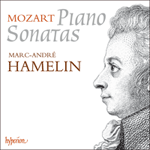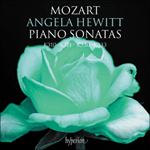
Welcome to Hyperion Records, a British classical label devoted to presenting high-quality recordings of music of all styles and from all periods from the twelfth century to the twenty-first.
Hyperion offers both CDs, and downloads in a number of formats. The site is also available in several languages.
Please use the dropdown buttons to set your preferred options, or use the checkbox to accept the defaults.

Like the slow movement of the recently composed F major Piano Concerto, K413, the B flat major Adagio transmutes the idiom of J C Bach into Mozartian poetry. The delicately sculpted main theme is immediately repeated in B flat minor, with a hint of wistfulness, and expressively ornamented in the recapitulation. The more elaborate embellishments in the first published edition (1784) were presumably added by Mozart himself, and give us a glimpse of his own improvisations.
Beginning with a flamboyant toccata-like flourish—the most technically demanding music in the sonatas K330–333—the 6/8 finale matches the opening Allegro’s abundance of contrasting ideas. As in the first two movements, the music turns readily to the minor both in the exposition (for a melancholy cantabile) and at the start of the development, where the toccata figuration erupts dramatically in C minor. Mozart surprisingly omits one of his themes—a gentle pastoral tune over a drone bass—from the recapitulation. But with his unerring feeling for balance and resolution he brings it back in the final bars to create a deliciously understated pianissimo ending.
from notes by Richard Wigmore © 2015
Comme le mouvement lent du récent Concerto pour piano en fa majeur, K413, l’Adagio en si bémol majeur transmue l’idiome de J. C. Bach en poésie mozartienne. Le thème principal subtilement sculpté est tout de suite repris en si bémol mineur, avec un soupçon de mélancolie, et orné avec expressivité à la réexposition. Les ornements davantage élaborés de l’édition princeps (1784) furent probablement ajoutés par Mozart lui-même, dont nous entrevoyons là les improvisations.
S’ouvrant sur une flamboyante fioriture de la toccata—épisode le plus technique des sonates K330–333—, le finale à 6/8 fait pendant à l’abondance d’idées contrastives de l’Allegro inaugural. Comme dans les deux premiers mouvements, la musique vire aisément au mineur dans l’exposition (pour un cantabile mélancolique) comme au début du développement, qui voit la figuration de toccata surgir de manière saisissante en ut mineur. Étonnamment, Mozart omet l’un de ses thèmes—un doux air pastoral par-dessus une basse en bourdon—à la réexposition. Mais, doué d’un infaillible sens de l’équilibre et de la résolution, il le ramène dans les dernières mesures pour une conclusion pianissimo délicieusement discrète.
extrait des notes rédigées par Richard Wigmore © 2015
Français: Hypérion
Wie im langsamen Satz des kurz vor der Sonate komponierten F-Dur-Klavierkonzertes, KV 413, wird im B-Dur-Adagio das Idiom von J. C. Bach in Mozartsche Poesie umgewandelt. Das delikat gebildete Hauptthema wird sogleich mit einem Anflug von Wehmut in b-Moll wiederholt, und dann erneut ausdrucksvoll verziert in der Reprise. Die ausgefeilteren Verzierungen in der Erstausgabe (1784) wurden vermutlich von Mozart selbst hinzugefügt und gewähren einen Blick auf seine eigenen Improvisationen.
Das 6/8-Finale beginnt mit einem auffallenden Toccata-artigen Tusch (die technisch anspruchsvollste Musik in den Sonaten KV 330–333) und hat die gleiche Fülle an kontrastierenden Gedanken wie der Kopfsatz, Allegro. Wie in den ersten beiden Sätzen wendet sich die Musik in der Exposition (bei einem melancholischen Cantabile) bald nach Moll, ebenso am Beginn der Durchführung, in der die Toccata-Verzierung dramatisch nach c-Moll ausbricht. Mozart läßt überraschenderweise eines der Themen fort—eine sanfte ländliche Weise über einem Bordunbaß aus der Reprise. Doch mit seinem unfehlbaren Gefühl für Balance und Auflösung bringt er es wieder in den letzten Takten für ein köstliches, unauffälliges pianissimo-Ende.
aus dem Begleittext von Richard Wigmore © 2015
Deutsch: Christiane Frobenius
 Hyperion sampler - November 2025 Vol. 2 Hyperion sampler - November 2025 Vol. 2 |
 Mozart: Piano Sonatas Mozart: Piano SonatasEight Sonatas, two Rondos, a Gigue and a Fantasia—the unique Marc-André Hamelin.» More |
 Mozart: Piano Sonatas K310-311 & 330-333 Mozart: Piano Sonatas K310-311 & 330-333Angela Hewitt’s voyage through Mozart’s piano sonatas is proving a joy, the works sounding newly minted in these vital, alert accounts.» More |
 Wanda Landowska - The complete piano recordings Wanda Landowska - The complete piano recordingsWanda Landowska (1879–1959) has achieved such fame for her 20th-century revival of the harpsichord that it is sometimes forgotten that she was a very fine pianist and continued to play music of the classical period on modern piano. This set brings ...» More |

